The U.S. Capitol’s National Statuary Hall Collection in Washington, D.C., hosts two statues of key figures from each state that have cultural or political resonance, from Thomas Edison to George Washington. This month, the assembly will get a new member: pioneering Kansan aviator Amelia Earhart.
The long-planned bronze statue, which is set to be unveiled to the public for the first time on July 27, was fully financed by the Atchison Amelia Earhart Foundation. The organization has been working to fund and commission the sculpture since 2013, though efforts to place a statue of Earhart stretch farther back: in 1999, the Kansas state legislature announced plans to replace statues of former governor George Washington Glick and former senator John James Ingalls with Dwight D. Eisenhower and Earhart, respectively.
Eisenhower was installed in 2003; Earhart’s journey took considerably longer, as funding and design delays put off the unveiling. Sculptors George and Mark Lundeen of Loveland, Colorado, created the Earhart sculpture. Another Earhart statue stands at Purdue University, where she worked as a women’s counselor and aeronautics adviser.
Earhart’s abbreviated life has long been the subject of speculation. She was the first woman to cross the Atlantic solo in an airplane; later, she and navigator Fred Noonan disappeared over the Pacific in 1937. Her speculated fate has ranged from being stranded on an island to having her remains devoured by coconut crabs.
Of the 100 statues in the collection, Earhart will be the 11th woman to be commemorated. Recently, Florida introduced a statue of educator and civil rights activist Mary McLeod Bethune, who becomes the first Black American to be honored in the Capitol's National Statuary Hall. Bethune's sculpture replaced Edmund Kirby Smith, a Confederate general.
